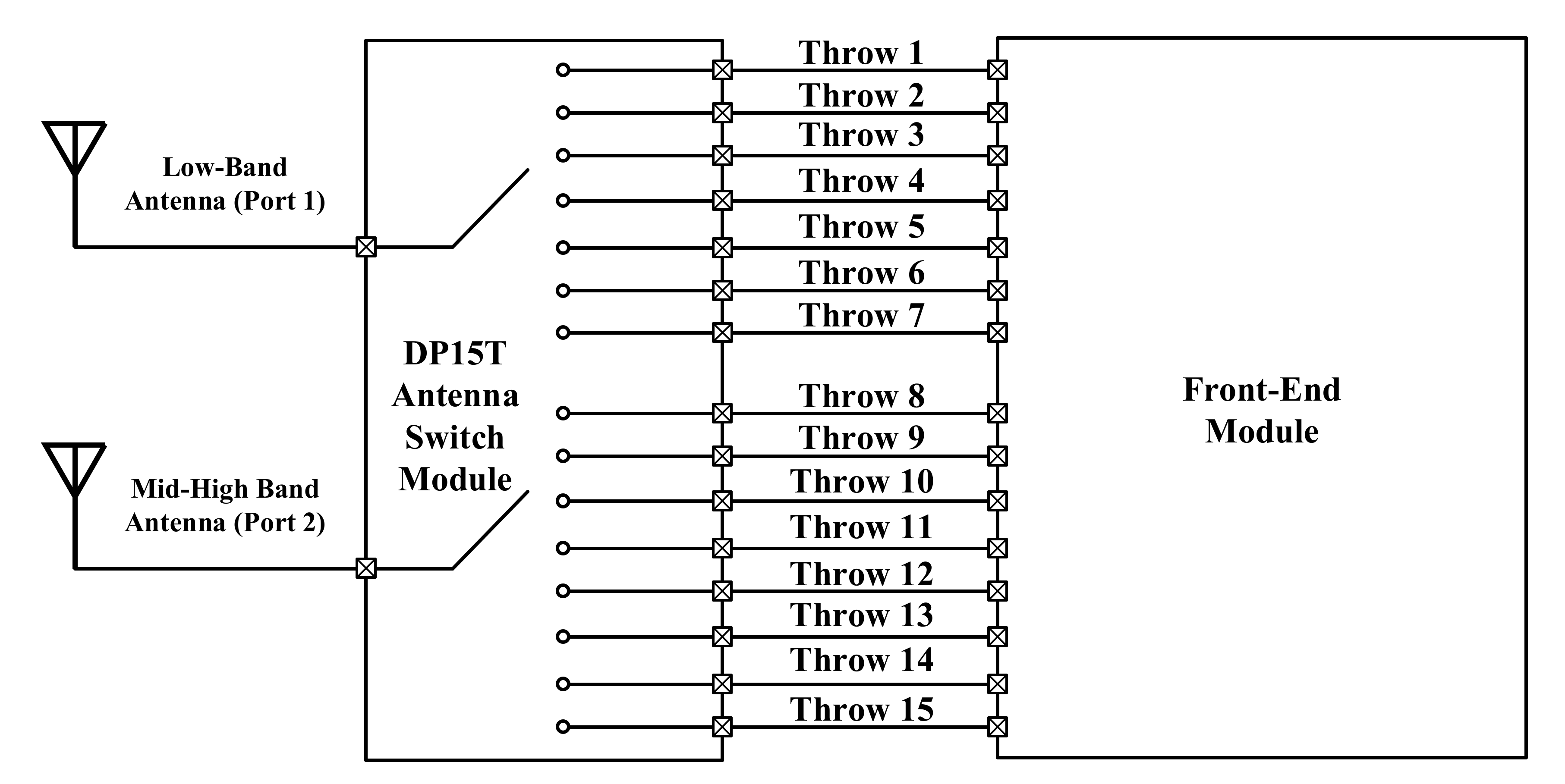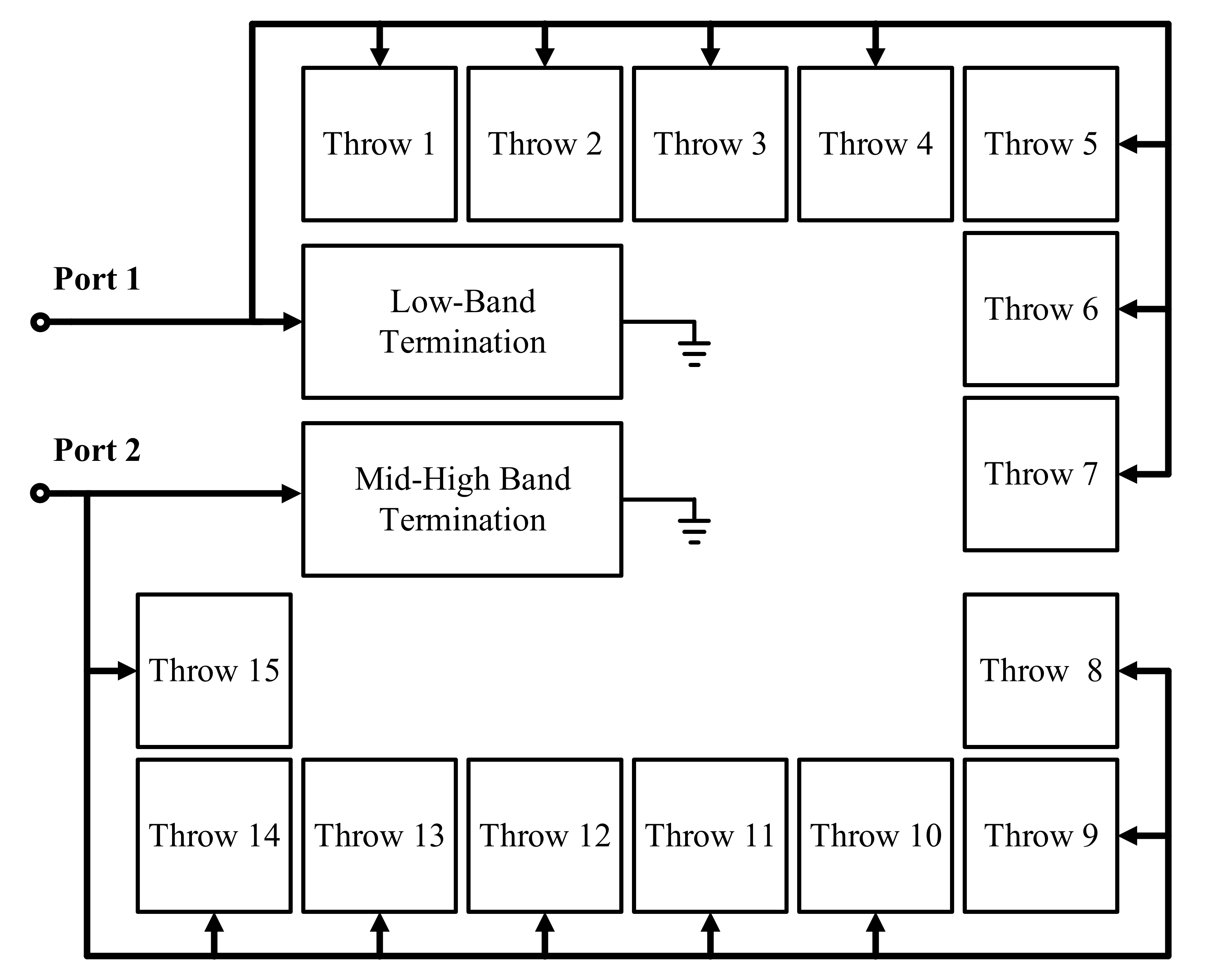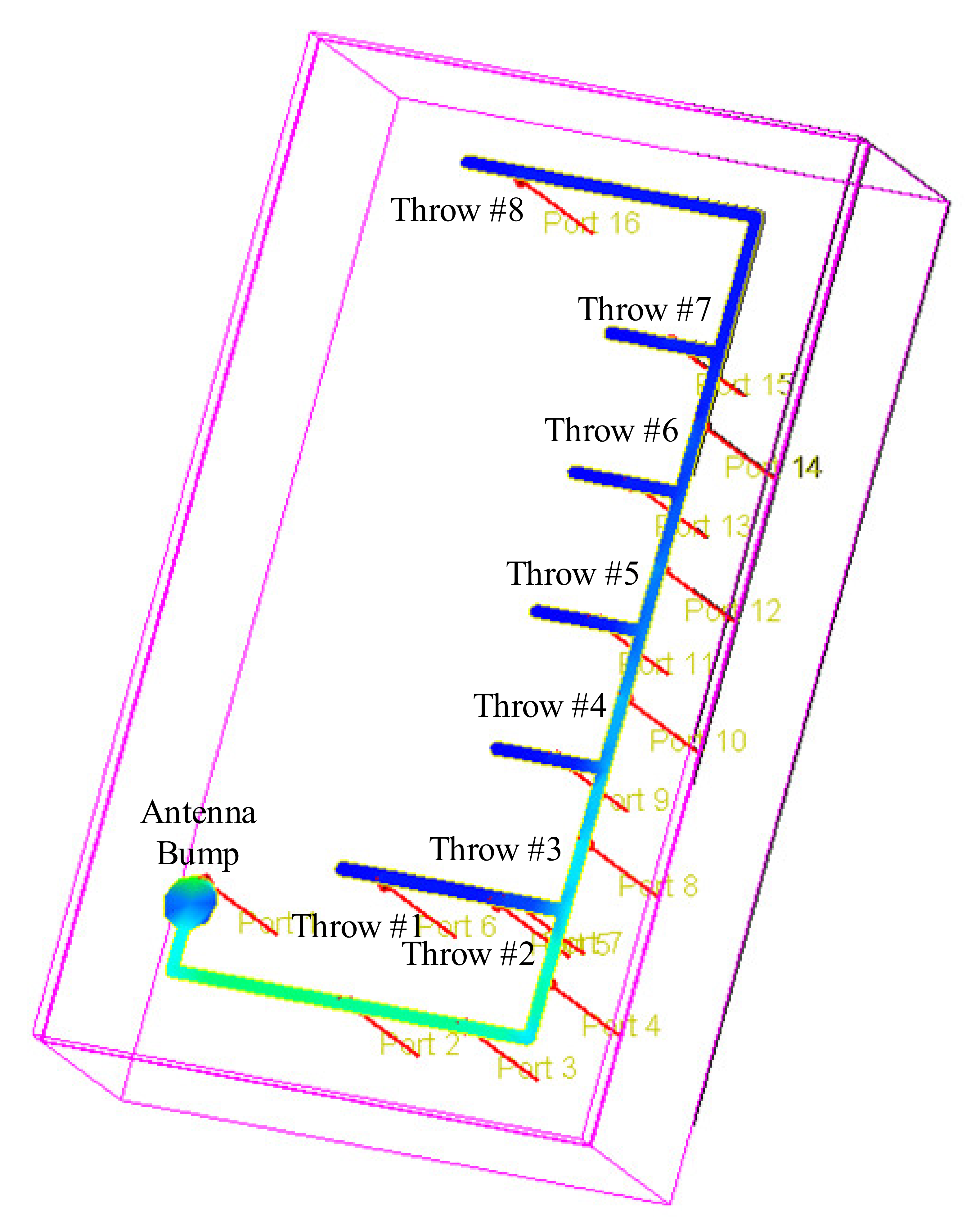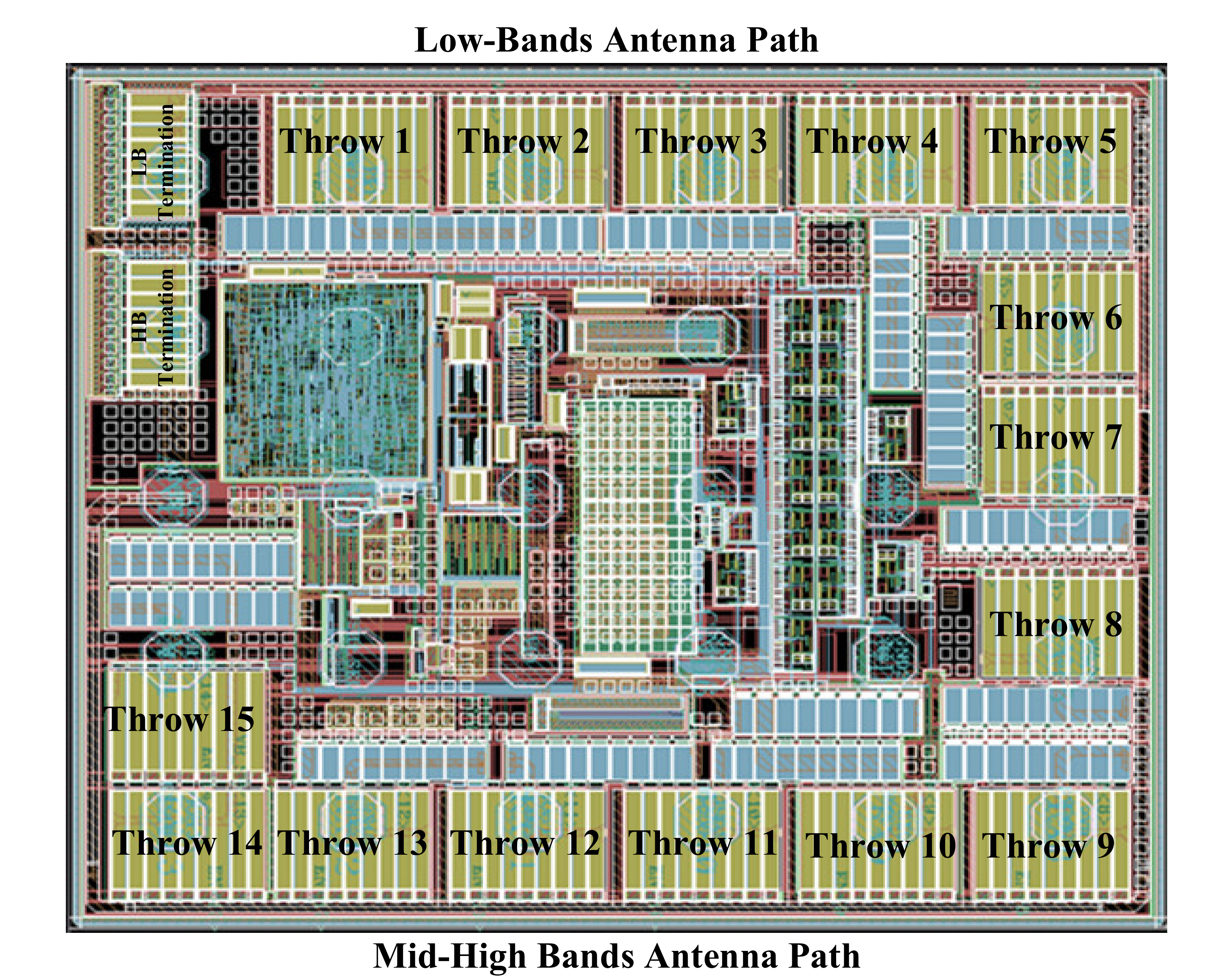A 0.617–2.7 GHz Highly Linear High-Power Dual Port 15 Throws Antenna Switch Module (DP15T-ASM) with
Abstract
:1. Introduction
2. The Proposed DP15T ASM
2.1. The Proposed Building Block
2.2. The Proposed Termination Circuit
2.3. The Proposed Branched Antenna
2.4. Circuit Implementation
3. Measurement Results
4. Conclusions
Author Contributions
Funding
Institutional Review Board Statement
Informed Consent Statement
Data Availability Statement
Acknowledgments
Conflicts of Interest
References
- Lin, D.M.; Huang, C.C.; Chan, Y.J. A symmetrical model for microwave power AlGaAs/InGaAs pHEMTs for switch circuit applications. IEEE Trans. Electron Devices 2009, 56, 2638–2643. [Google Scholar] [CrossRef]
- Yore, M.D.; Nevers, C.A.; Cortese, P. High-isolation low-loss SP7T pHEMT switch suitable for antenna switch modules. In Proceedings of the Microwave Integrated Circuits Conference (EuMIC), Paris, France, 27–28 September 2010. [Google Scholar]
- Shin, O.C.; Kim, Y.S.; Jeong, I.H. Implementation of new SP6T switch achieving high quality and small size at same time. In Proceedings of the IEEE Asia-Pacific Microwave Conference, Yokohama, Japan, 7–10 December 2010. [Google Scholar]
- Tombak, A.; Iversen, C.; Pierres, J.B.; Kerr, D.; Carroll, M.; Mason, P.; Spears, E.; Gillenwater, T. Cellular antenna switches for multimode applications basedon a Silicon-on-Insulator technology. In Proceedings of the IEEE Radio Frequency Integrated Circuits Symposium, Anaheim, CA, USA, 23–25 May 2010. [Google Scholar]
- Bonkowski, J.; Kelly, D. Integration of triple-band GSM antenna switch module using SOI CMOS. In Proceedings of the IEEE Radio Frequency Integrated Circuits Symposium, Forth Worth, TX, USA, 6–8 June 2004. [Google Scholar]
- Tombak, A. Silicon-on-insulator (SOI) switches for cellular and WLAN front-end applications. In Proceedings of the IEEE Radio Frequency Integrated Circuits Symposium, Montreal, QC, Canada, 17–19 June 2012; pp. 17–22. [Google Scholar]
- Marshall, A.; Natarajan, S. PD-SOI and FD-SOI: A comparison of circuit performance. In Proceedings of the 9th International Conference on Electronics, Circuits and Systems, Dubrovnik, Croatia, 15–18 September 2002. [Google Scholar]
- Vanhoenacker-Janvier, D.; El Kaamouchi, M.; Moussa, M.S. Silicon-on-insulator for high-temperature applications. In Proceedings of the 1992 International Technical Digest on Electron Devices Meeting, San Francisco, CA, USA, 13–16 December 1992; Volume 25, pp. 151–157. [Google Scholar]
- Wei, A.; Sherony, M.J.; Antoniadis, D.A. Effect of floating-body charge on SOI MOSFET design. IEEE Trans. Electron Devices 1998, 45, 430–438. [Google Scholar] [CrossRef]
- Chan, M.; Su, P.; Wan, H.; Lin, C.H.; Fung SK, H.; Niknejad, A.M.; Hu, C.; Ko, P.K. Modeling the floating-body effects of fully depleted, partially depleted, and body-grounde SOI MOSFETs. Solid-State Electron. 2004, 48, 969–978. [Google Scholar] [CrossRef]
- Koh, Y.H.; Oh, M.R.; Lee, J.W.; Yang, J.W.; Lee, W.C.; Kim, H.K. Body-contacted SOI MOSFET structure and its application to DRAM. IEEE Trans. Electron Devices 1998, 45, 1063–1070. [Google Scholar]
- Burke, D.R.; El Kaamouchi, M.; Vanhoenacker-Janvier, D. DC and large-signal microwave MOSFET model applicable to partially-depleted, body-contacted SOI technology. In Proceedings of the 2007 IEEE/MTT-S International Microwave Symposium, Honolulu, HI, USA, 3–8 June 2007; pp. 585–588. [Google Scholar]
- Tinella, C.; Richard, O.; Cathelin, A.; Reaute, F.; Majcherczak, S.; Blanchet, F.; Belot, D. 0.13 μm CMOS SOI SP6T antenna switch for multi-standard handsets. In Proceedings of the Digest of Papers. 2006 Topical Meeting on Silicon Monolithic Integrated Circuits in RF Systems, San Diego, CA, USA, 18–20 January 2006; pp. 58–61. [Google Scholar]
- Tombak, A.; Carroll, M.S.; Kerr, D.C.; Pierres, J.B.; Spears, E. Design of high-order switches for multimode applications on a silicon-on-Insulator technology. IEEE Trans. Microw. Theory Tech. 2013, 61, 3639–3649. [Google Scholar] [CrossRef]
- Wang, X.S.; Yue, C.P. A dual-band SP6T T/R switch in SOI CMOS with 37-dBm P-0.1-dB for GSM/W-CDMA handsets. IEEE Trans. Microw. Theory Tech. 2014, 62, 861–870. [Google Scholar] [CrossRef]
- Blaschke, V.; Unikovski, A.; Hurwitz, P.; Chaudhry, S. A SP9T cellular antenna switch in 2.5 V CMOS thin-film SOI. In Proceedings of the 2013 IEEE 13th Topical Meeting on Silicon Monolithic Integrated Circuits in RF Systems, Austin, TX, USA, 21–23 January 2013; pp. 144–146. [Google Scholar]
- Cui, J.; Chen, L.; Liu, Y. Monolithic single-pole sixteen-throw T/R switch for next-generation front-end module. IEEE Microw. Wirel. Compon. Lett. 2014, 24, 345–347. [Google Scholar] [CrossRef]
- Im, D.; Kim, B.K.; Im, D.K.; Lee, K. A Stacked-FET Linear SOI CMOS Cellular Antenna Switch with an Extremely Low-Power Biasing Strategy. IEEE Trans. Microw. Theory Tech. 2015, 63, 1964–1977. [Google Scholar] [CrossRef]
- Zhang, Z.; Zhang, G.; Yu, K.; Lin, J.; Huang, L. Effects and contrasts of silicon-on-insulator floating-body and body-contacted field-effect transistors to the design of high-performance antenna switches. IET Microw. Antennas Propag. 2016, 10, 507–516. [Google Scholar] [CrossRef]
- Zhang, Z.; Zhang, G.; Yu, K.; Lin, J.; Liu, Z. A 0.1 to 2.7-GHz SOI SP8T antenna switch adopting body self-adapting bias technique for low-loss high-power applications. Int. J. Circuit Theory Appl. 2018, 46, 827–841. [Google Scholar] [CrossRef]
- Wu, L.; Ng, A.; Zheng, S.; Leung, H.F.; Chao, Y.; Li, A.; Luong, H.C. A 0.9–5.8-GHz Software-Defined Receiver RF Front-End with Transformer-Based Current-Gain Boosting and Harmonic Rejection Calibration. IEEE Trans. Very Large Scale Integr. Syst. 2017, 25, 2371–2382. [Google Scholar] [CrossRef]
- Wu, L.; Ng, A.W.; Zheng, S.; Leung, H.F.; Chao, Y.; Li, A.; Luong, H.C. A SP9T cellular antenna switch in 2.5 V CMOS thin-film SOI. In Proceedings of the IEEE Silicon Monolithic Integrated Circuits RF Systems Conference, Austin, TX, USA, 21 January 2013. [Google Scholar]
- Wang, D.; Wolf, R.; Joseph, A.; Botula, A.; Rabbeni, P.; Boenke, M.; Harame, D.; Dunn, J. High Performance SOI RF Switches for Wireless Applications. In Proceedings of the 2010 10th IEEE International Conference on Solid-State and Integrated Circuit Technology, Shanghai, China, 1–4 November 2010. [Google Scholar]










| Parameters | [19] | [22] | [23] | This Work |
|---|---|---|---|---|
| Supply Voltage (V) | 2.5 | 2.5 | 2.5 | 1.8 |
| Frequency Range (GHz) | 0.9–1.9 | 0.9–1.9 | 0.9–1.9 | 0.617–2.7 |
| Structure | SP8T | SP9T | SP8T | DP15T (SP8T + SP7T) |
| Insertion Loss (dB) | 0.53–0.65 | 0.42–0.55 | 0.65–0.78 | 0.34–0.92 |
| Minimum Isolation (dB) | 38.4–29.3 | 26–20 | 45–37 | 49–35.5 |
| 2nd Harmonic (dBc) | −78–−75.5 | −90–−90 | −80–N/A | −92–−89 |
| 3rd Harmonic (dBc) | −81.6–−79.9 | −76–−82 | −85–N/A | −97.2–−88 |
| Power Handling (dBm) | 38.4 | 36 | 35 | 35 |
| Process Technology | SOI-CMOS | SOI-CMOS | SOI-CMOS | SOI-CMOS |
| Maximum 2nd and 3rd IMDs (dBm) | N/A | N/A | N/A | −100 |
| Size (mm2) | 1.21 | 1.52 | N/A | 0.74 |
| Number of total RF connections (ports and throws) | 8 | 6.2 | 20.7 | 2.71 |
| Termination Mode | NO | NO | NO | YES |
| F.O.M. | 0.134 | 0.152 | N/A | 0.043 |
Publisher’s Note: MDPI stays neutral with regard to jurisdictional claims in published maps and institutional affiliations. |
© 2022 by the authors. Licensee MDPI, Basel, Switzerland. This article is an open access article distributed under the terms and conditions of the Creative Commons Attribution (CC BY) license (https://creativecommons.org/licenses/by/4.0/).
Share and Cite
Rad, R.E.; Choi, K.-D.; Kim, S.-J.; Pu, Y.-G.; Jung, Y.-J.; Huh, H.-K.; Yoo, J.-M.; Kim, S.-K.; Lee, K.-Y.
A 0.617–2.7 GHz Highly Linear High-Power Dual Port 15 Throws Antenna Switch Module (DP15T-ASM) with
Rad RE, Choi K-D, Kim S-J, Pu Y-G, Jung Y-J, Huh H-K, Yoo J-M, Kim S-K, Lee K-Y.
A 0.617–2.7 GHz Highly Linear High-Power Dual Port 15 Throws Antenna Switch Module (DP15T-ASM) with
Rad, Reza E., Kyung-Duk Choi, Sung-Jin Kim, Young-Gun Pu, Yeon-Jae Jung, Hyung-Ki Huh, Joon-Mo Yoo, Seok-Kee Kim, and Kang-Yoon Lee.
2022. "A 0.617–2.7 GHz Highly Linear High-Power Dual Port 15 Throws Antenna Switch Module (DP15T-ASM) with
Rad, R. E., Choi, K.-D., Kim, S.-J., Pu, Y.-G., Jung, Y.-J., Huh, H.-K., Yoo, J.-M., Kim, S.-K., & Lee, K.-Y.
(2022). A 0.617–2.7 GHz Highly Linear High-Power Dual Port 15 Throws Antenna Switch Module (DP15T-ASM) with






